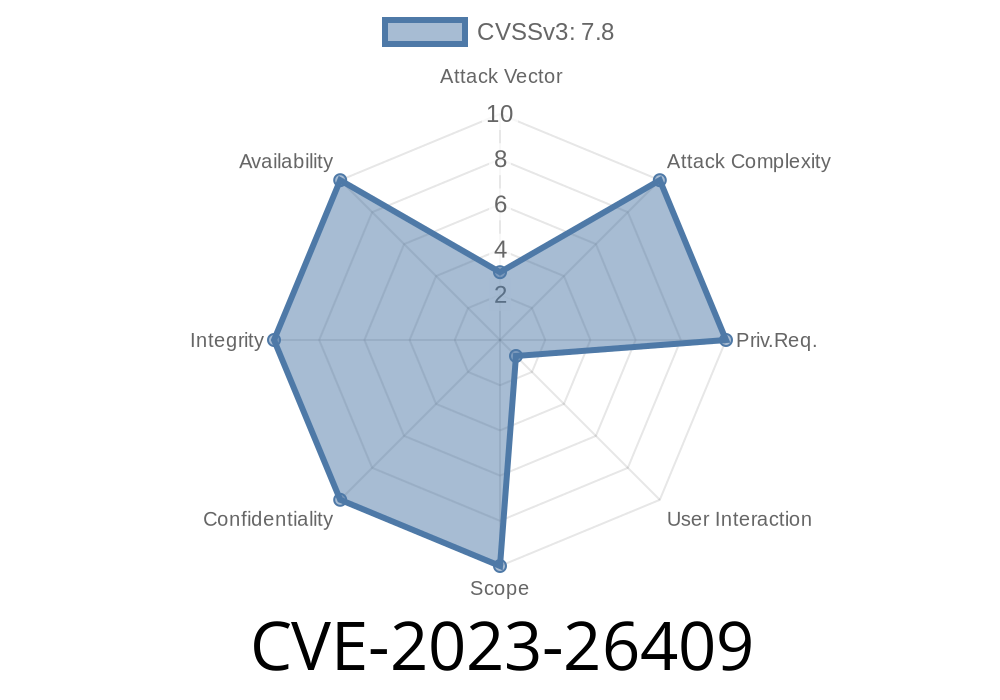Adobe Substance 3D Designer is a popular tool used in the world of 3D graphics for creating textures and materials. But as with any complex piece of software, vulnerabilities can slip in. In this deep dive, we'll break down CVE-2023-26409, a serious out-of-bounds read bug discovered in Adobe Substance 3D Designer version 12.4. (and earlier). We’ll explain how it works in plain language, provide example code, and link to official sources.
What is CVE-2023-26409?
CVE-2023-26409 is an out-of-bounds read vulnerability present in Adobe Substance 3D Designer’s file parsing mechanism. This means that when the program tries to read information, it may go past the end of an allocated block of memory. If an attacker crafts a special file and tricks a victim into opening it, this bug can be used to run code in the context of the victim.
Official References
- Adobe Security Bulletin APSB23-13
- NIST National Vulnerability Database Entry
Technical Background – “Out-of-Bounds Read” Explained
When programs work with files, they read data into memory “buffers.” An out-of-bounds read happens when the software doesn’t check carefully before reading, and accidentally grabs data from outside the safety of that buffer. Sometimes this just causes a crash, but in some cases, an attacker can use the extra data read to their advantage—stealing memory, crashing the program, or even executing their own code.
In Adobe Substance 3D Designer, the problem happens when it parses its project files (SBS or SBSAR formats). If a file is crafted to be just the right way, the program may try to read more data than is actually in memory.
Here’s a simplified snippet that demonstrates how such a bug might look in C++
// Vulnerable pseudo-code demonstrating an out-of-bounds read
void parse_file(const uint8_t* data, size_t size) {
// Suppose 'size' is smaller than needed
uint32_t field_length = *(uint32_t*)(data + 8); // Reads 4 bytes at offset 8
// Oops - no length check!
uint8_t* field_data = new uint8_t[field_length];
memcpy(field_data, data + 12, field_length);
// If data+12 goes past the end of 'data', this reads out-of-bounds!
}
What’s wrong here?
There’s no check to make sure that data+12+field_length isn’t past the end of the buffer. If an attacker edits the file to set an oversized field_length, the code will read into adjacent memory it shouldn’t access.
Let’s walk through a simple exploit scenario
1. Attacker crafts a malicious .sbs file. In this file, the attacker purposely sets a length field to a very large number.
The bug triggers: the software reads memory outside the boundaries assigned for the file.
5. With careful crafting, that extra memory can contain code or control data, letting the attacker hijack program execution.
How Code Execution Could Happen
Modern operating systems have security features, but out-of-bounds reads (and especially if they're paired with a write operation) are a path toward full code execution exploits. By leaking information about how the program or system is laid out in memory (using the out-of-bounds data), attackers can defeat protections like ASLR, and eventually craft an attack that executes arbitrary code.
Proof-of-Concept (POC) Steps
Here’s a POC approach based on public patterns. (Note: This is for educational use only!)
Suppose the .sbs file starts like this (hex)
00 01 02 03 04 05 06 07 99 99 99 99 ff ff ff ff
Offset 12-16 (ff ff ff ff) is not part of actual data but will be read anyway.
When loaded, the bug will cause the program to read up to x99999999 bytes—well past the file boundary!
Possibly cause the app to crash in a way that lets further attacks proceed
A skilled attacker might use the info-leak to chain into a full code execution exploit, especially if there’s another linked vulnerability (like an out-of-bounds write or a use-after-free).
Defense and Recommendations
- Update Immediately: Adobe fixed this bug in later versions of Substance 3D Designer (Update available here). Always keep your tools updated.
Conclusion
CVE-2023-26409 is a classic example of how a seemingly simple memory bug can endanger designers, artists, and studios using high-end 3D software. As attackers grow smarter and security gets tighter, these bugs show us—again—why regular updates, cautious file handling, and secure development matter every day.
For more details, always check the official Adobe Security Bulletins and keep up to date with vulnerability trackers like CVE Details or the NVD.
*Stay safe, stay updated, and don’t let your creativity be a hacker’s door in!*
Timeline
Published on: 04/13/2023 20:15:00 UTC
Last modified on: 04/14/2023 13:06:00 UTC
